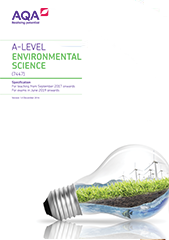Appendix C: Previous science learning
To develop skills and knowledge in A-level Environmental Science, students should have the skills and knowledge associated with at least GCSE Combined Science or equivalent. While an understanding of all GCSE Combined Science or equivalent topics is advantageous, there are a number of topics that have particular applications in A-level Environmental Science.
The following table illustrates the GCSE Combined Science topics that have particular applications in the development of skills and knowledge in A-level Environmental Science.
| GCSE Combined Science topic | Application in A-level Environmental Science |
|---|---|
| Osmosis |
Hydrosphere: unsustainable exploitation. |
| Levels of organisation within an ecosystem |
Conservation of biodiversity. Life processes in the biosphere and conservation planning. |
| The principle of material cycling |
Biogeochemical cycles. Sustainability. |
| Biodiversity |
Conservation of biodiversity. Life processes in the biosphere and conservation planning. Sustainability. |
| The genome |
The importance of the conservation of biodiversity:
Agriculture: genetic manipulation. |
| Variation and evolution |
The importance of the conservation of biodiversity:
Agriculture: genetic manipulation. |
| Selective breeding and gene technology |
The importance of the conservation of biodiversity:
Agriculture: genetic manipulation. |
| Chemical symbols, formulae and equations, including reaction stoichiometry and masses of reactants and products |
Global climate change Ozone depletion Biogeochemical cycles Energy Pollution |
| Chemistry of acids |
Pollution:
|
| Electrolysis |
Energy:
|
| Exothermic and endothermic reactions |
Energy Sustainability |
| Carbon compounds |
Energy Sustainability |
| Life cycle assessment and recycling |
Mineral resources Sustainability |
| Fractional distillation of crude oil and cracking |
Energy: fossil fuels. |
| Different methods of extracting and purifying metals |
Mineral resources Sustainability |
| The composition and evolution of the Earth’s atmosphere since its formation |
Atmosphere |
| Carbon dioxide and methane as greenhouse gases |
Atmosphere Sustainability: carbon footprints. |
| Common atmospheric pollutants and their sources |
Pollution |
| The Earth’s water resources and obtaining potable water |
The hydrosphere |
| Conservation, dissipation and national |
Energy |
|
Atomic structure |
Energy: nuclear power. Pollution: ionising radiation. |
